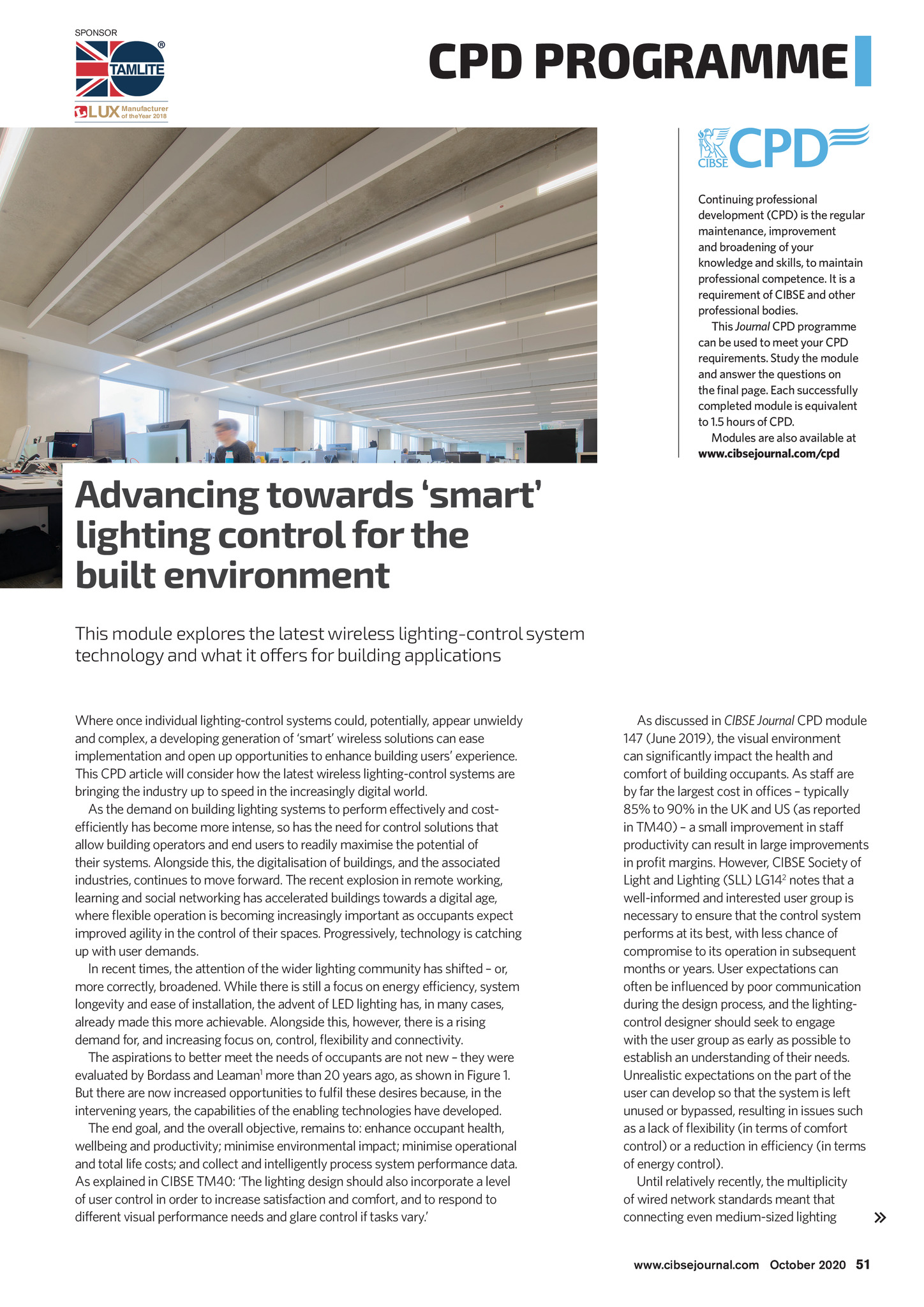


SPONSOR CPD PROGRAMME LUX Manufacturer of theYear 2018 Continuing professional development (CPD) is the regular maintenance, improvement and broadening of your knowledge and skills, to maintain professional competence. It is a requirement of CIBSE and other professional bodies. This Journal CPD programme can be used to meet your CPD requirements. Study the module and answer the questions on the final page. Each successfully completed module is equivalent to 1.5 hours of CPD. Modules are also available at www.cibsejournal.com/cpd Advancing towards smart lighting control for the built environment This module explores the latest wireless lighting-control system technology and what it offers for building applications Where once individual lighting-control systems could, potentially, appear unwieldy and complex, a developing generation of smart wireless solutions can ease implementation and open up opportunities to enhance building users experience. This CPD article will consider how the latest wireless lighting-control systems are bringing the industry up to speed in the increasingly digital world. As the demand on building lighting systems to perform effectively and costefficiently has become more intense, so has the need for control solutions that allow building operators and end users to readily maximise the potential of their systems. Alongside this, the digitalisation of buildings, and the associated industries, continues to move forward. The recent explosion in remote working, learning and social networking has accelerated buildings towards a digital age, where flexible operation is becoming increasingly important as occupants expect improved agility in the control of their spaces. Progressively, technology is catching up with user demands. In recent times, the attention of the wider lighting community has shifted or, more correctly, broadened. While there is still a focus on energy efficiency, system longevity and ease of installation, the advent of LED lighting has, in many cases, already made this more achievable. Alongside this, however, there is a rising demand for, and increasing focus on, control, flexibility and connectivity. The aspirations to better meet the needs of occupants are not new they were evaluated by Bordass and Leaman1 more than 20 years ago, as shown in Figure 1. But there are now increased opportunities to fulfil these desires because, in the intervening years, the capabilities of the enabling technologies have developed. The end goal, and the overall objective, remains to: enhance occupant health, wellbeing and productivity; minimise environmental impact; minimise operational and total life costs; and collect and intelligently process system performance data. As explained in CIBSE TM40: The lighting design should also incorporate a level of user control in order to increase satisfaction and comfort, and to respond to different visual performance needs and glare control if tasks vary. As discussed in CIBSE Journal CPD module 147 (June 2019), the visual environment can significantly impact the health and comfort of building occupants. As staff are by far the largest cost in offices typically 85% to 90% in the UK and US (as reported in TM40) a small improvement in staff productivity can result in large improvements in profit margins. However, CIBSE Society of Light and Lighting (SLL) LG142 notes that a well-informed and interested user group is necessary to ensure that the control system performs at its best, with less chance of compromise to its operation in subsequent months or years. User expectations can often be influenced by poor communication during the design process, and the lightingcontrol designer should seek to engage with the user group as early as possible to establish an understanding of their needs. Unrealistic expectations on the part of the user can develop so that the system is left unused or bypassed, resulting in issues such as a lack of flexibility (in terms of comfort control) or a reduction in efficiency (in terms of energy control). Until relatively recently, the multiplicity of wired network standards meant that connecting even medium-sized lighting www.cibsejournal.com October 2020 51 CIBSE Oct20 pp51-54 CPD169 Tamlite Supp v2.indd 51 25/09/2020 16:47